Keeping inventory in stock can be a challenge for Amazon sellers in normal times, but pandemic-era supply chain disruptions have made it even more difficult, causing some businesses to pivot, to say the least.
Amazon businesses of all sizes reported experiencing supply chain-related challenges during 2021. This included 94% of large brands selling their products on Amazon, 93% of ecommerce brand management agencies, and 74% of small first- and third-party Amazon businesses.
And these challenges were not insignificant:
- As many as 93% of ecommerce sellers lost revenue
- The majority of ecommerce sellers said their inventory was delayed 2 months or more
- Sellers modified their business strategies by launching a new/different product, finding alternative fulfillment options, or adjusting their advertising spend, among other methods
Inventory management is crucial for sellers on Amazon. Ecommerce businesses need to find the ideal balance between having too much inventory and not enough inventory. If brands have an excess of inventory, they can accrue costly storage fees, and, if brands have insufficient inventory on hand, they can lose sales by going out of stock.
Note: Tools like Inventory Manager can help business owners stay on top of their ecommerce inventory.

Ecommerce businesses faced a challenging supply chain environment over the past year, which made managing inventory a challenge: Container ships were stuck at sea outside of jammed ports, unable to unload their cargo that was to be shipped to places like FBA warehouses.
In addition, factories in China had to stop work due to the spread of COVID-19 and power outages that led manufacturing facilities to stop production. And, in Europe, a bustling port was “blockaded” by climate protests.
How else did supply chain disruptions impact ecommerce businesses on Amazon, and what are some of the strategies that these businesses took to prevent or counteract these challenges?
Jungle Scout recently surveyed* 3,500 ecommerce sellers about their businesses, including goals and challenges they faced in the past year, which highlighted how they dealt with supply chain challenges.
What kinds of supply chain challenges are sellers facing?
Supply chain challenges are impacting ecommerce businesses in a number of ways — from inventory order delays to the appearance of listings on Amazon. This is true for small businesses as well as large brands selling products on Amazon.
- 48% of large brands report that their inventory orders were delayed between 1 month and 4 months.
- 42% of large brands report that they are unable to order new inventory from their supplier and 27% of small business owners said the same.
- 44% of large brands and 26% of small businesses report that their existing inventory was affected by supply chain issues.
- 23% of large brands and 11% of small businesses report losing the Buy Box because products went out of stock due to supply chain issues
- The cost of moving a container to the West Coast of the U.S. from China surpassed $20,000 during the apex of logistics challenges in the summer of 2021.
1. Long delays
After ordering inventory from a supplier, ecommerce businesses can expect to have to wait for their orders — on a good day – and particularly if their orders are shipped by sea. But a number of these companies are experiencing inventory order delays on top of the usual manufacturing time amid supply chain challenges – and they tend to face long delays if their product orders are late.
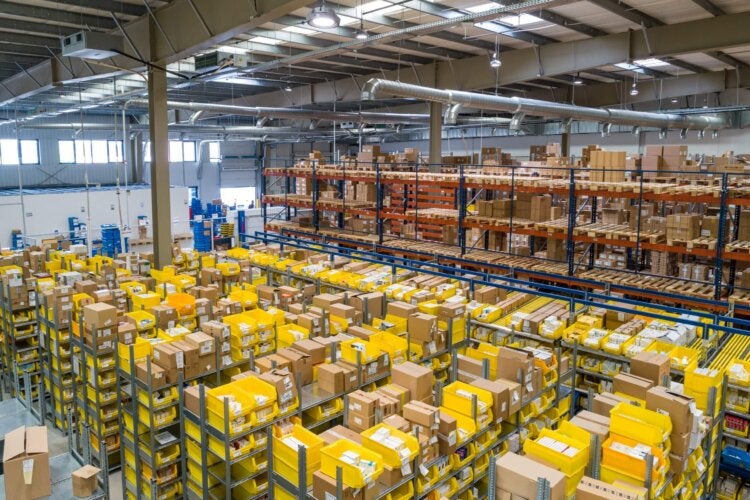
Inventory order delays are widespread across ecommerce businesses on Amazon. Unfortunately, sellers tend to experience delays that last longer than one month on inventory orders.
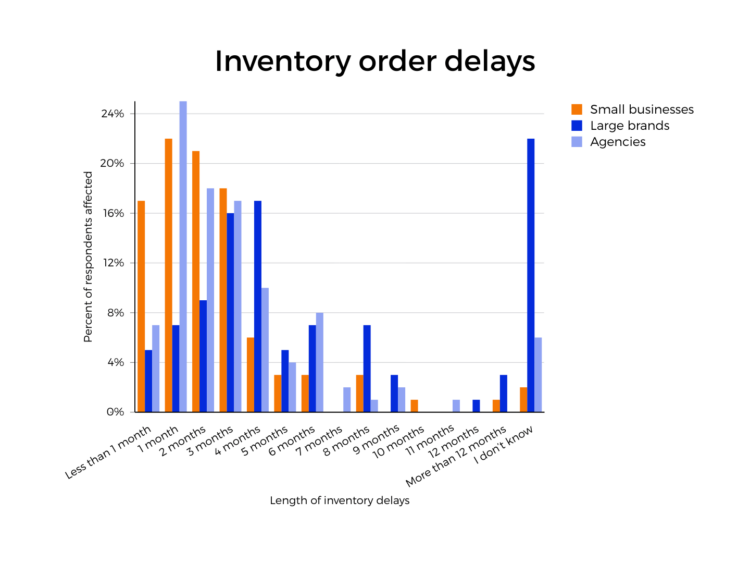
These delays can have a cascading impact on Amazon sellers. One seller notes: “Delays in supply chain affected sales which affected revenues which had knock-on effects when self-funding inventory purchase and when attempting to take out a bank bridging loan.”
Ecommerce businesses can plan for unexpected delays, as not everything runs smoothly all the time: For example, sellers can order backup units in the event of a supply chain disruption.
2. Supplier issues
Sellers don’t just face universal supply chain-related problems like delayed inventory orders: they also contend with issues stemming from their own suppliers. Some sellers are not able to get in contact with their supplier in the first place, let alone order new inventory. Moreover, a small percentage of ecommerce businesses report that their supplier went out of business.
Supplier issue
SMB
Large brands
Agency
Unable to order new inventory from supplier
27%
42%
36%
Supplier(s) became inaccessible
11%
21%
18%
Supplier(s) went out of business
5%
15%
13%
However, Amazon sellers can take steps to find a reliable supplier to place a new order – or find a new supplier when an existing one goes out of business or is otherwise unavailable. Tools such as the Supplier Database can provide access to high-quality manufacturers.
3. Existing inventory
Supply chain challenges are not only impacting sellers’ orders for new inventory: These issues also impact inventory that they already have in their possession. How could that happen? In one case, brands might have to move their existing inventory out of storage to avoid racking up storage fees. A sizable share of ecommerce businesses reported that their current inventory was affected by supply chain issues:
- 26% of small businesses
- 44% of large brands
- 38% of agencies (clients’ businesses)
4. Shipping expenses
High shipping costs amid supply chain challenges are also hitting ecommerce businesses’ bottom lines — particularly those ecommerce businesses that import their goods from afar. One Amazon seller reports:
“Shipping cost increased from $1.60/ unit to $8.00/unit. Totally killed my profits as I am launching. [The] business model won’t work if these costs remain high. I really need to localize. I wish I had better supplier resources from the US, Mexico, or Central America vs. China.”
This seller is not alone: The cost of moving a container to the West Coast of the U.S. from China soared over the pandemic. While it took under $2,000 on average for a container to make this trip in 2019, that cost surpassed $20,000 during the apex of logistics challenges in the summer of 2021.
5. Ownership of the Buy Box
Inventory management issues can also negatively impact how a brand’s items appear on Amazon — and how easily customers can buy them. It is crucial for brands to win the Buy Box, the widget of an Amazon listing that lets shoppers quickly purchase products. Around 82% of sales on Amazon go to the sellers or brands that have “won” the Buy Box for a given product — and other sellers have to compete for those few remaining sales.
Unfortunately, supply chain challenges complicate brands’ efforts to win the Buy Box. To be able to “win” and maintain the Buy Box, a seller needs to stay in good standing with Amazon — by having great shipping performance, adhering to Amazon’s Terms of Service, and offering good customer service, for instance. Sellers can lose the Buy Box by going out of stock, which is exactly what happened to 23% of large brands, 11% of small businesses, and another 11% of agency clients in 2021.
For example, Shinola lost the Buy Box on this product listing because it is currently out-of-stock:

Beyond the Buy Box, supply chain challenges also negatively impact the product rankings of some brands. 24% of large brands report that their products lost rankings on Amazon due to supply chain challenges, while 17% of agencies note the same about their clients’ businesses.
Large ecommerce businesses experience large losses
Large brands report higher estimated lost sales to supply chain challenges than small businesses. After all, large brands tend to place much larger orders for inventory and have more to lose if it arrives late – or if they can’t source more in the first place.
While 45% of small businesses estimate that their lost sales due to supply chain issues totaled under $5,000, 30% of small businesses report that their estimated losses totaled between $5,001 and $25,000:
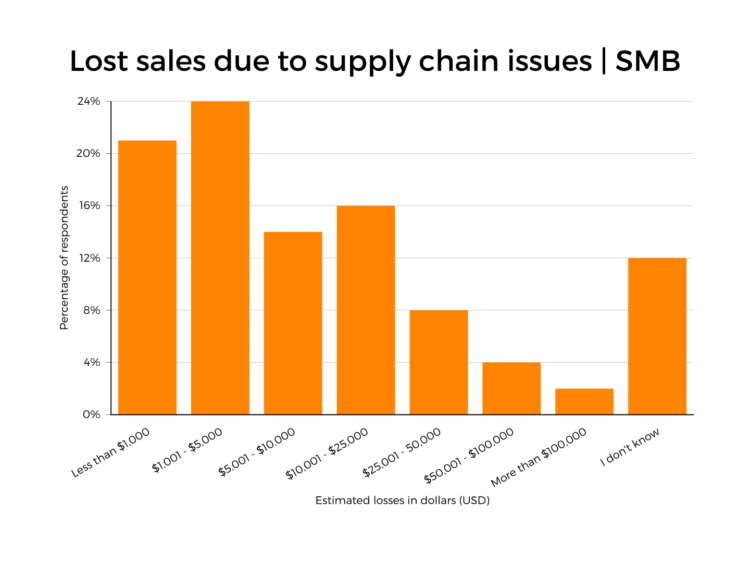
By contrast, 18% of large brands estimate that their lost sales for their company were under $50,000, while 51% of agencies reported the same for their clients:
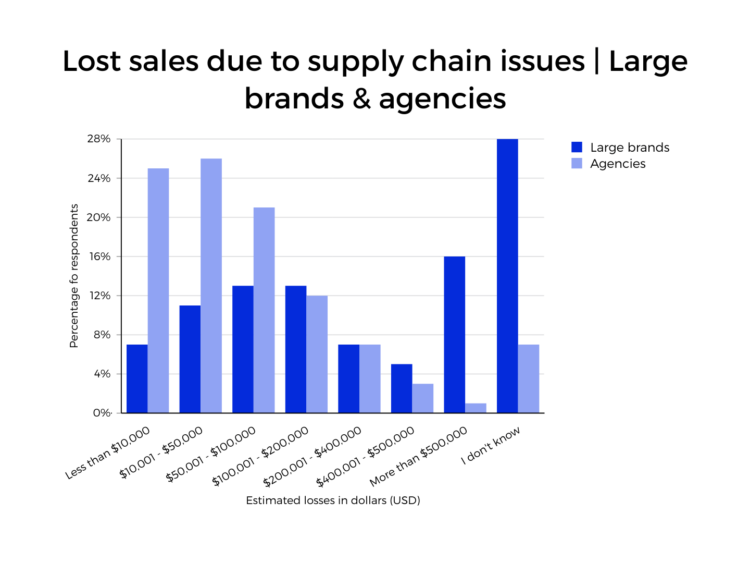
Fortunately, just 16% of large brands report that their estimated loss sales totaled over $500,000, and only 1% of agencies reported the same about their clients’ business.
Sources of delayed inventory orders
Brands import their inventory from all around the world, but China is the top importer for the United States by a wide margin: China accounts for 42% of all merchandise transported to the U.S.
It is not surprising that China is the top source of inventory orders for large brands that were impacted by supply chain challenges — just by the sheer volume of shipments that move from the country to the U.S. each day:
How do ecommerce businesses respond to supply chain disruptions?
As sellers encounter supply chain challenges, they do not sit idle: Many of these businesses put various strategies into action to respond to these issues. These are the strategies that ecommerce businesses undertake:
- Reduce advertising spend
- Small businesses 20%
- Large brands 37%
- Change fulfillment methods
- Small businesses 20%
- Large brands 34%
- Launch a new product
- Small businesses 24%
- Large brands 32%
- Rent/buy more inventory storage space
- Small businesses 9%
- Large brands 25%
- Discontinue a product
- Small businesses 18%
- Large brands 22%
Large brands took additional measures, like changing suppliers (27%) and increasing advertising spend to sell their well-stocked products (17%). They also raised product prices on Amazon and began scheduling their inventory orders months earlier than usual to account for delays.
The road ahead
Supply chain disruptions have hampered ecommerce businesses large and small, delaying inventory orders, reducing sales, and impacting product rankings on Amazon.
To what degree will sellers face these supply chain headwinds in 2022? Time will tell, but market observers already predict that these challenges will continue deep into this year.
Amazon sellers: How were you impacted by supply chain challenges over the past year? What are you doing to prevent and counteract these issues? Share your experiences in the comments.
*Methodology
Between December 1, 2021 – January 3, 2022, Jungle Scout surveyed 3,500 Amazon sellers, including prospective and former sellers. Respondents represent 117 countries on all 20 Amazon marketplaces and all relevant Amazon product categories.
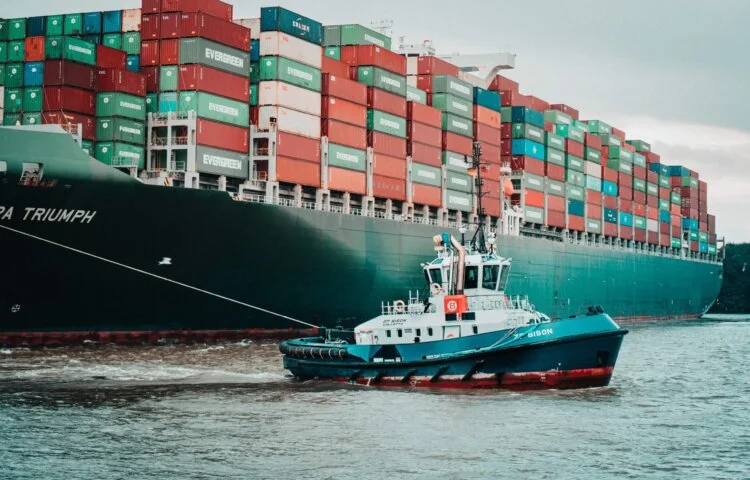
 7 Comments
7 Comments
7 comments on “How Supply Chain Challenges Are Impacting Amazon Sellers”